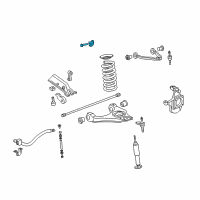< Back ×
2004 Cadillac Escalade EXT Camber and Alignment Kit
My Vehicle Change Vehicle
2004 Cadillac Escalade EXT
< Back to View All
Alignment Kits
- Department
- Prices
OEM (Genuine) 2004 Cadillac Escalade EXT Cam Kit, Front Upper Control Arm Adjust
PartNumber: 12472859Product Specifications- Notes: 4WD
- Location: Driver Side; Passenger Side
- Other Names: Adjust Cam
- Item Dimensions: 6.1 x 5.8 x 3.3 inches
- Item Weight: 2.60 Pounds
- Part Description: Cam Kit, Front Upper Control Arm Adjust
FAQ for Camber and Alignment Kit Repair
Q: What should be noticed when making a D Height Measurement?
A:
There are no specified trim height specifications on leaf spring vehicles because it is not an adjustable feature. The height of the suspension will depend on the option content of the vehicle as well as the aftermarket equipment that is placed on the vehicle. The measurements are used for comparison only and should be within 15 mm with the vehicle at the curb and no accessories.
By Bob
GM Specialist
01/11/2022Q: What is the recommended bolt torque for the cam nuts?
A:
The recommended bolt torque is 190 Nm (140 ft. lbs.).
By Bob
GM Specialist
01/11/2022Q: What should we do when prompted by the scan tool?
A:
When prompted by the scan tool you must turn the steering wheel a full 90° to the left and a full 90° to the right and then to center and hold. If this step is not done properly then it is possible to cause a false DTC for the steering wheel position sensor.
By Bob
GM Specialist
01/11/2022Q: What is the Wheel Alignment Procedure?
A:
You need to turn the ignition to ON position, with the engine ON, install the scan tool, center the steering wheel, lift the rear of the vehicle off the ground ensure the rear wheels are centered, and go to the Learn Alignment menu choice in the scan tool, follow the prompts on the scan tool. Press the continue button, and use the scan tool to clear all rear-wheel steering DTCs.
By Bob
GM Specialist
01/11/2022Q: What should be noticed when adjusting the front caster and camber?
A:
Caster measurements or valves must be compensated for the measured frame angle.
By Bob
GM Specialist
01/11/2022Q: What should be noticed when making a Z Height Measurement?
A:
All dimensions are measured from vertical to the ground. Cross-vehicle Z heights should be within 12 mm (0.47 inch) to be considered correct.
By Bob
GM Specialist
01/11/2022Q: What is the recommended bolt torque for the jam nut on the tie rod?
A:
The recommended bolt torque is 65 Nm (48 ft. lbs.).
By Bob
GM Specialist
01/11/2022Q: What should be noticed before adjusting the caster and camber angles?
A:
Before adjusting the caster and camber angles, jounce the front bumper three times to allow the vehicle to return to its normal height. Measure and adjust the caster and the camber with the vehicle at curb height. The front suspension Z dimension is indicated in Trim Heights.
By Bob
GM Specialist
01/11/2022Q: What is the adjustment procedure for the rear toe?
A:
You need to loosen the jam nut on the tie rod, rotate the inner tie rod to the required toe specification setting, tighten the jam nut on the tie rod, check the toe setting after tightening and re-adjust the toe setting if necessary.
By Bob
GM Specialist
01/11/2022Q: What should we do before measuring the trim heights?
A:
You should make sure the vehicle is on a level surface, remove the alignment rack floating pins, set the tire pressures to the pressure shown on the certification label, check the fuel level, add additional weight if necessary to simulate a full tank, make sure the rear storage compartment is empty and close the doors and hood.
By Bob
GM Specialist
01/11/2022See more FAQs (7)

